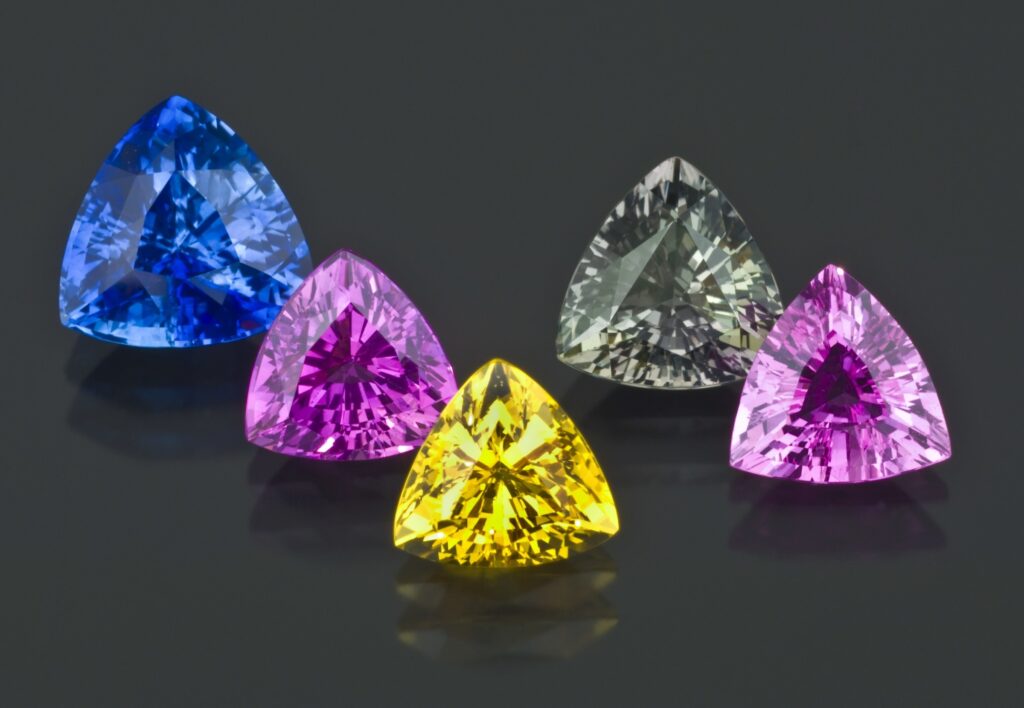Sapphires come in a wide range of colors, and each color has its own quality variations. In general, the more intense the color and the fewer the distracting zones of unattractive color, the more valuable the stone.
Color has the most important influence on blue sapphire’s value. The most highly valued blue sapphires are velvety blue to violetish blue, in medium to medium dark tones. Preferred sapphires also have strong to vivid color saturation. The saturation should be as strong as possible without darkening the color and compromising brightness. Sapphires with these qualities command the highest prices per carat.
At the other end of the price scale are commercial-grade sapphires with greenish blue color or strong greenish blue pleochroism. Pleochroism is different colors seen in different crystal directions. Less valuable blue sapphires might be grayish, too light, or too dark.
The major fancy sapphire color categories are padparadscha, pink and purple, orange and yellow, green, and colorless and black. Each category has its own color range, causes of color, and market.
The fancy sapphires that people in the trade call padparadscha are very beautiful. They typically have a high per-carat value, too—much higher than other types of fancy sapphires.
Their color can be hard to describe. Some people say padparadscha sapphire colors should be called salmon or sunset. Others compare the color to the flesh of a ripe guava.
In spite of these differing color descriptions, people in the industry usually agree that padparadscha sapphire colors are intensely saturated and range from light to medium pinkish orange to orange-pink.
Color-change sapphires are corundum’s chameleons—stones that change color under different lighting. Under daylight equivalent (fluorescent) light, the typical color-change sapphire’s basic color ranges from blue to violet. Under incandescent light, it ranges from violetish purple to strongly reddish purple. Some rare color-change sapphires change from green in daylight to reddish brown in incandescent light.
When gem experts judge color-change sapphires, they describe the color change as weak, moderate, or strong. The strength of the stone’s color change is the most important quality factor affecting its value, followed in importance by the actual colors of the stone.
As with all colored stones, the color of star corundum has a great effect on its value. The best star corundum has a crisp, distinct star against strongly saturated color. If the color is too light, it doesn’t provide enough contrast for the star’s rays, and the star will be less visible.
Star corundum can be red, blue, black, gray, purple, or yellow—practically every color under the sun. The term “star sapphire” encompasses all colors of star corundum except red, which is called star ruby.
Naturally, some colors of star corundum are valued more highly than others. In general, the most prized colors are the same as the colors most valued in non-phenomenal corundum: red and blue.
Trade terms based on sources can represent certain colors and qualities that are associated with a stone’s source. The qualities might be typical of that source or they might represent the finest stones from that source. But a single source never consistently yields gems that are all the same color and quality. In fact, the descriptive term might represent only a small percentage of stones from that source. The appearance of stones from a particular source often varies over time, and the original quality associated with that source might no longer match the material produced.
New sources can produce material very similar to that from classical sources or with a slightly different, but just as beautiful, appearance.



